Today I’m sharing a breakdown of my 2023 quilting income, as I’ve done for several years now (2022, 2021, 2020, 2019, 2018). As always, a bit of context up front:
- I have a full-time engineering job, and my husband has a full-time engineering job, and we do not rely on quilting as an income source for our family.
- Because my quilting income is supplemental, I may have different priorities and make different decisions than those for whom quilting is a full-time job.
- That said, I firmly believe in being fairly compensated for my time and effort and rarely work for free.
- The income breakdown below is based on gross income.
- Percentages are rounded.
- Important 2023 notes! I bought a new longarm and sold my old longarm. These two transactions were the two biggest transactions I made this year, and skew my numbers accordingly, so I’ve included pie charts both with and without the purchase/sale of longarms.
- My new longarm was significantly more expensive than what I earned from selling my old one. Even with those numbers, I still had a (small) net profit this year which is very satisfying!
The TL;DR; version of this year’s report is that my numbers look VERY similar to 2022. But let’s dive in!
—–
Income
(The numbers and percentages in this section address gross income WITHOUT the sale of my old longarm.)
In 2023, my gross income decreased by 5%. I exceeded $30,000 for the second year in a row — but just barely. The category percentages didn’t change drastically from last year either:
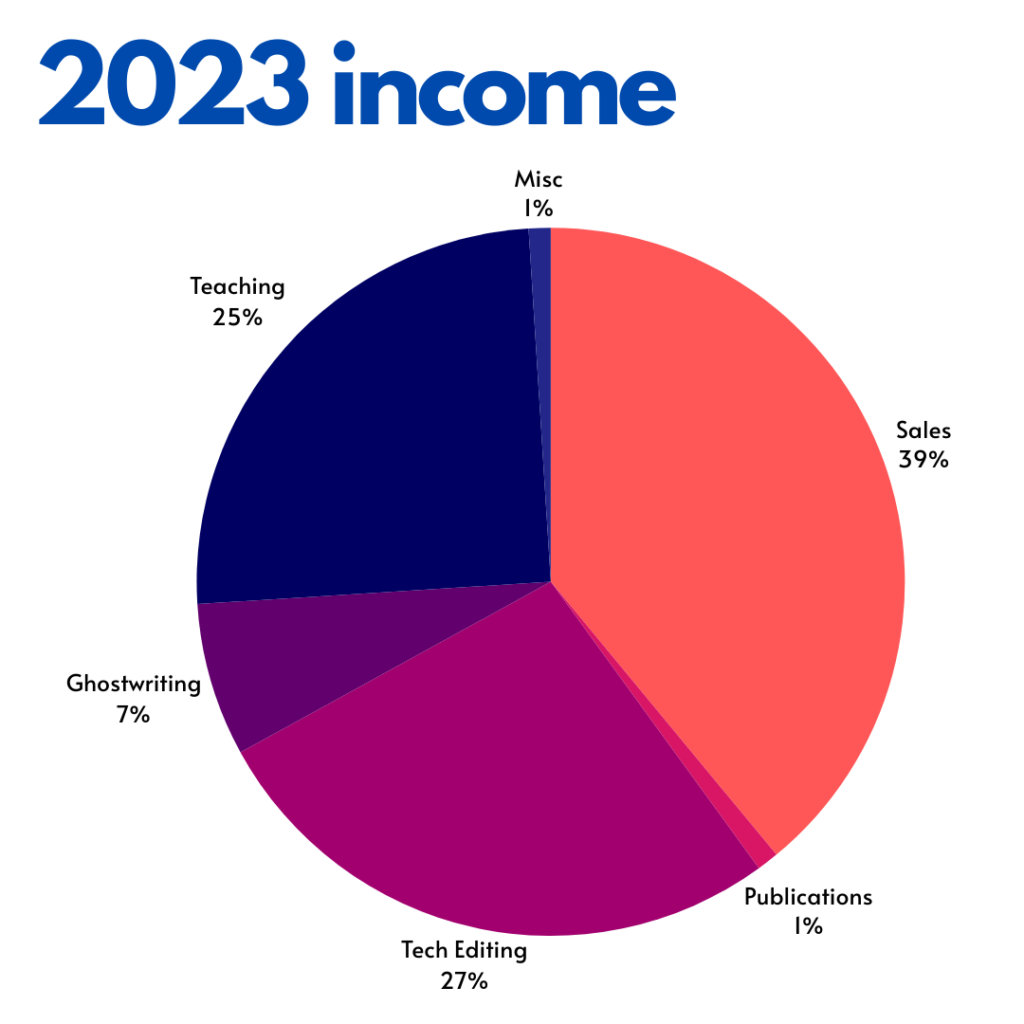
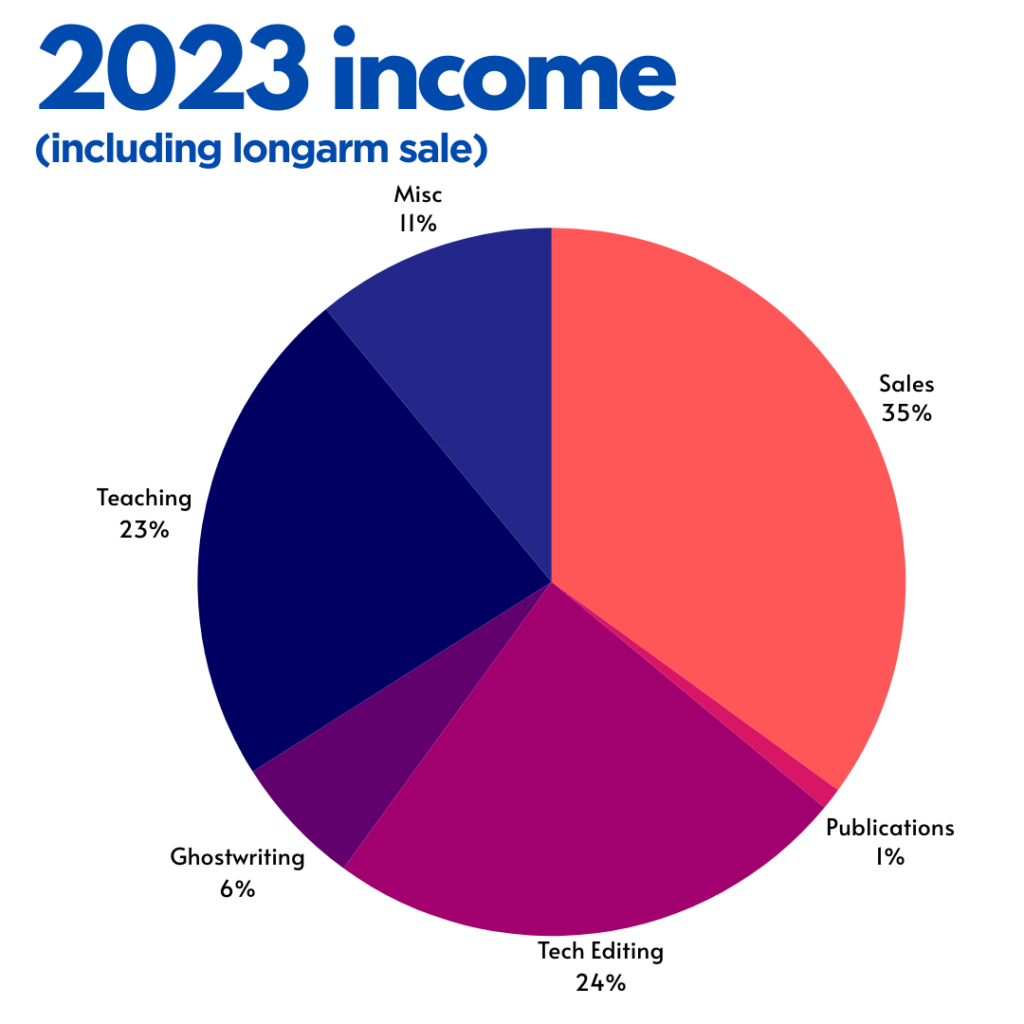
Sales – 39% (Last year: 34%)
My gross sales income came from seven sources: my new Shopify-powered store (which I set up last January), my Etsy shop (where I still sell PDF patterns but no longer send traffic), Quilt Pattern Mart (which closed this fall), wholesale orders, distributor orders, royalty payments (for one specific pattern), and in-person sales at lectures/workshops.
“Sales” includes patterns, workshop supply kits, finished items, and courses such as the Tech Editing 101 webinar I hosted with Yvonne Fuchs.
I released 2 patterns last year and now have 16 published patterns available in PDF and 14 available in print. My patterns continue to be carried by Checker Distributors, and I was picked up by Brewer Sewing this year as well. I have contacted United Notions and spoke with their rep at Quilt Market in November, but unfortunately have not made any headway with their team yet.
I hope to add 2-3 more patterns to my catalog in 2024. I am also interested in adding additional course/webinar/education options, both on my own and in cooperation with others. The tech editing webinar was Yvonne’s idea, but I really enjoyed doing it with her and was happy that she thought of me for that!
Publications – 1% (Last year: 3%)
This is not something I really pursued in 2023. This number got rounded up to 1%, and represents a single magazine article that will be coming out early in 2024.
Tech Editing – 27% (Last year: 18%)
Ghostwriting & Design – 7% (Last year: 17%)
Tech editing and ghostwriting/design — the two primary “flavors” of services I provide to other quilt pattern designers — represented another ~1/3 or $10,000+ of my income. I continued to both work with previous clients and pick up new clients via referrals.
In the second half of the 2022, I began to scale back on ghostwriting projects and you can clearly see that I continued that in 2023! My tech editing income increased as I continue to add new clients and added editing/review work for a major fabric manufacturer, and my ghostwriting income decreased as I became more choosey about the projects I accepted. I will continue offering this service on a limited basis in 2024, and focus on projects that align with my interests and preferences. (If you have a project you’d like me to consider, contact me!)
Teaching – 25% (Last year: 23%)
In 2023 I presented 9 lectures (7 virtual and 2 in-person) and taught 9 workshops (3 virtual and 6 in-person). I continue to enjoy teaching and hope to be able to sustain something like 10-12 engagements per year.
I currently have 4 lectures and 1 workshop already booked with guilds for 2024, and will be doing 1 lecture and 2 workshops at QuiltCon 2024. I applied to teach at International Quilt Festival this past year and was not accepted, but I will be applying again with hopes of teaching at IQF in 2024.
If I would be a good fit for your guild or organization, I’d love to chat with you!
Miscellaneous – 1% (Last year: 5%)
This category is the catch-all for anything that didn’t quite fit into one of the other categories. In 2023, my only item in this category was Reels bonus payments from Instagram. Still bummed that those went away, ha!
—–
Expenses
(The numbers and percentages in this section address expenses WITHOUT the purchase of my new longarm.)
My expenses this year totaled a bit over $6,000. The breakdown below DOES NOT include federal income tax. (And note that I live in Texas, which does not have state income tax.)
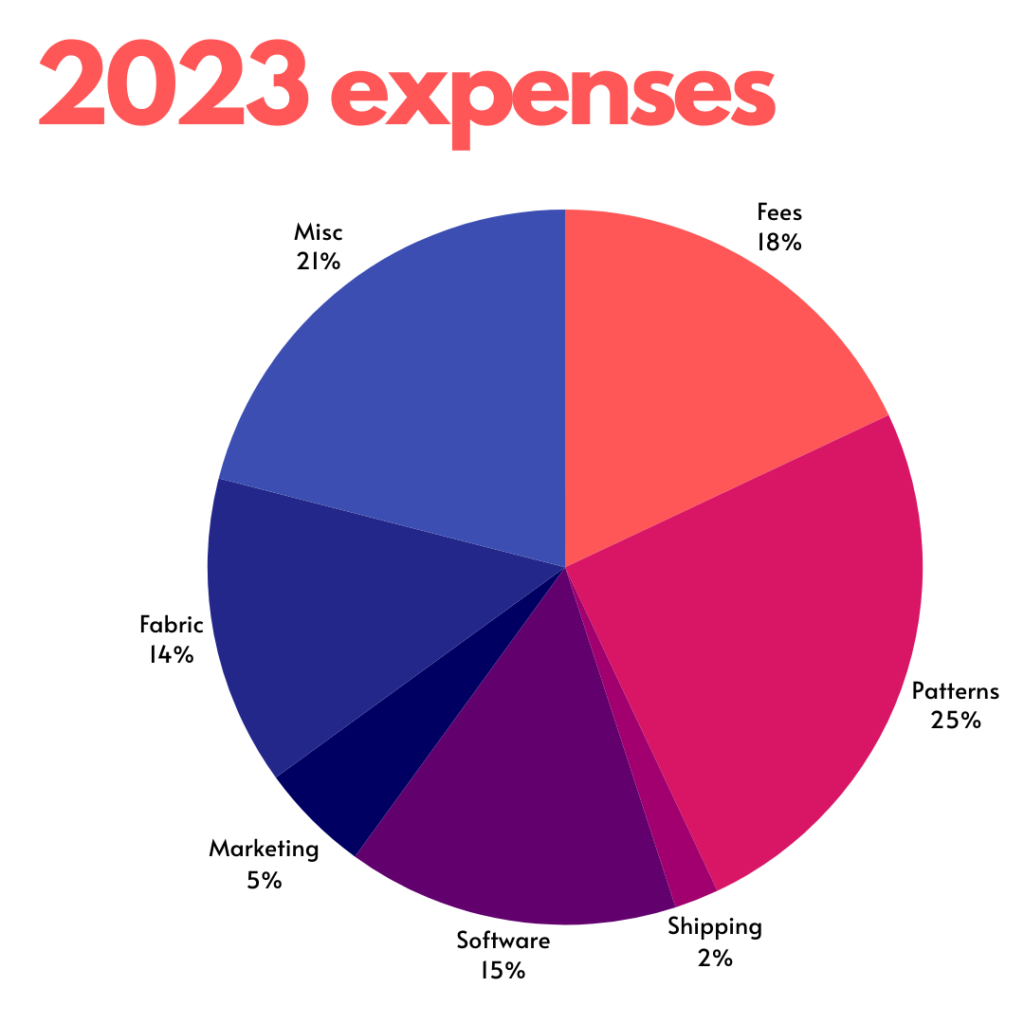
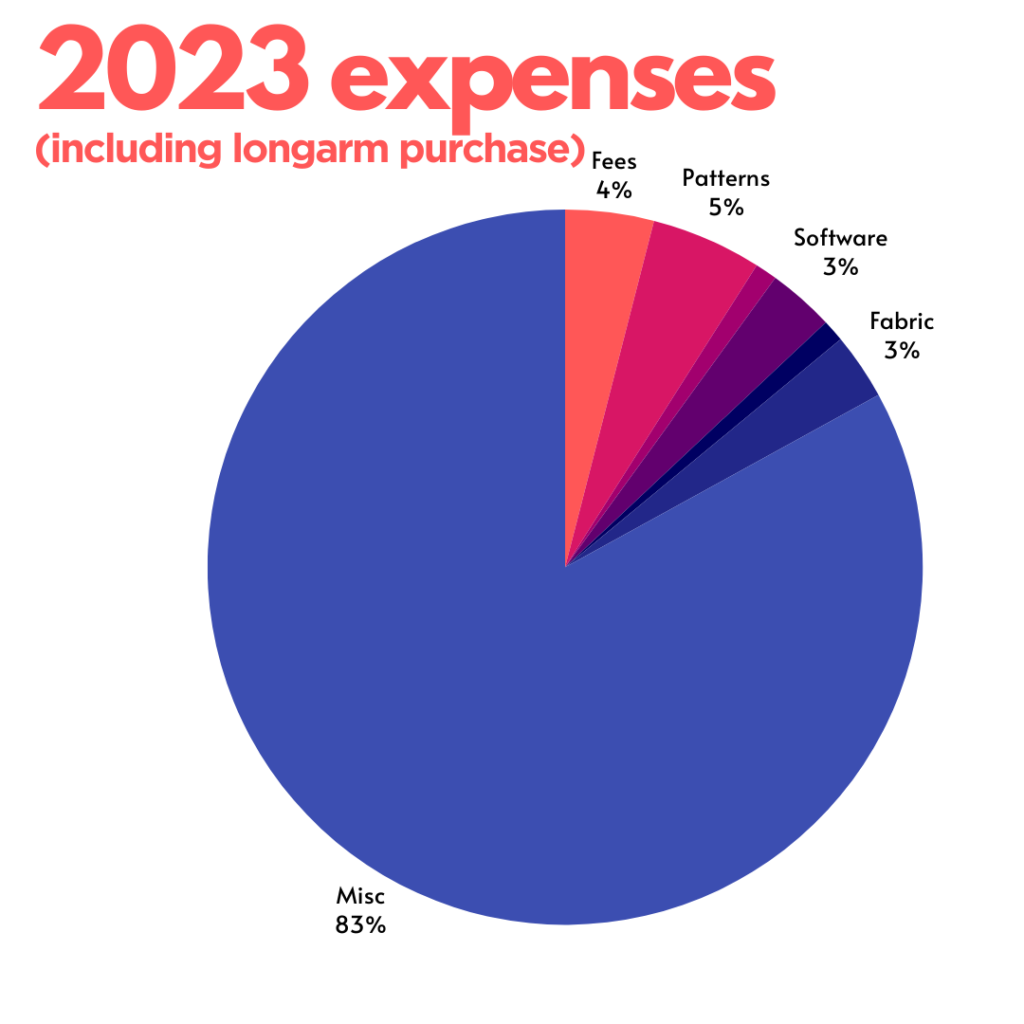
Fees & Commissions – 18% (Last year: 20%)
There are three primary sources of fees: Paypal (which I use for invoicing clients), Shopify (payment processing fees), Etsy (listing and sales fees), and Quilt Pattern Mart (banking/sales fees plus commission). Ultimately, these kind of fees are just a cost of doing business.
I will transitioned to Shopify for my primary shop for last January. Shopify has fewer fees per transaction than Etsy, but Shopify also charges a monthly fee while Etsy does not. Overall, switching to Shopify did slightly reduce my fees, so that’s nice — and means I had enough sales to make the switch worth it. I’m also able to give Shopify customers the choice to join my email list, which I could not do with Etsy, and that’s very valuable as well.
Printing & Pattern Expenses – 25% (Last year: 26%)
This includes the cost for all of my print patterns and the cost of having new patterns tech edited. I print in batches of 75-100 copies of a pattern at a time, which means my print cost per pattern is higher than someone who sells enough to print in batches of 500-1000. But it is what it is!
Shipping – 2% (Last year: 9%)
This includes both the postage I pay to mail print pattern orders and the shipping materials themselves like envelopes and pattern bags. With my change to Shopify, I was able to improve my shipping set up and save a bit of money. I also didn’t have to spend anything significant on envelopes, etc this year because I bought in bulk in 2022.
Software – 15%
I separated software/internet things into their own category this year. This includes the monthly cost of the Adobe software suite (Illustrator, InDesign, and Photoshop), domain and web hosting for this site and my Shopify store, and Zoom fees for the months I needed a pro account.
Marketing – 5% (Last year: 7%)
The biggest expense in this category is my newsletter service (Flodesk) but it also includes promo materials like stickers for QuiltCon and business cards.
Fabric & Making Expenses – 14% (Last year: 11%)
Most self-explanatory! This includes fabric I bought for projects, along with a few print pantographs I purchased in the last month to play with on my longarm. I also had one quilt longarmed by someone else earlier this year, and I included that cost in this category.
Miscellaneous Expenses – 21% (Last year: 18%)
This category is another catch-all and includes things like my virtual PO box, materials for my postcard supply packs, Quilt Market registration fees, show entry fees, and online courses/memberships. For 2024, I plan to make quilt show entry fees and professional memberships their own category.
—–
So that’s my 2023 breakdown! It’s always good to look back and think about how I have earned and spent business money this year, along with what is and isn’t working. I’ve also updated my year-to-year income grown chart below, showing the drop in my gross income this year. I fully expected that this might happen
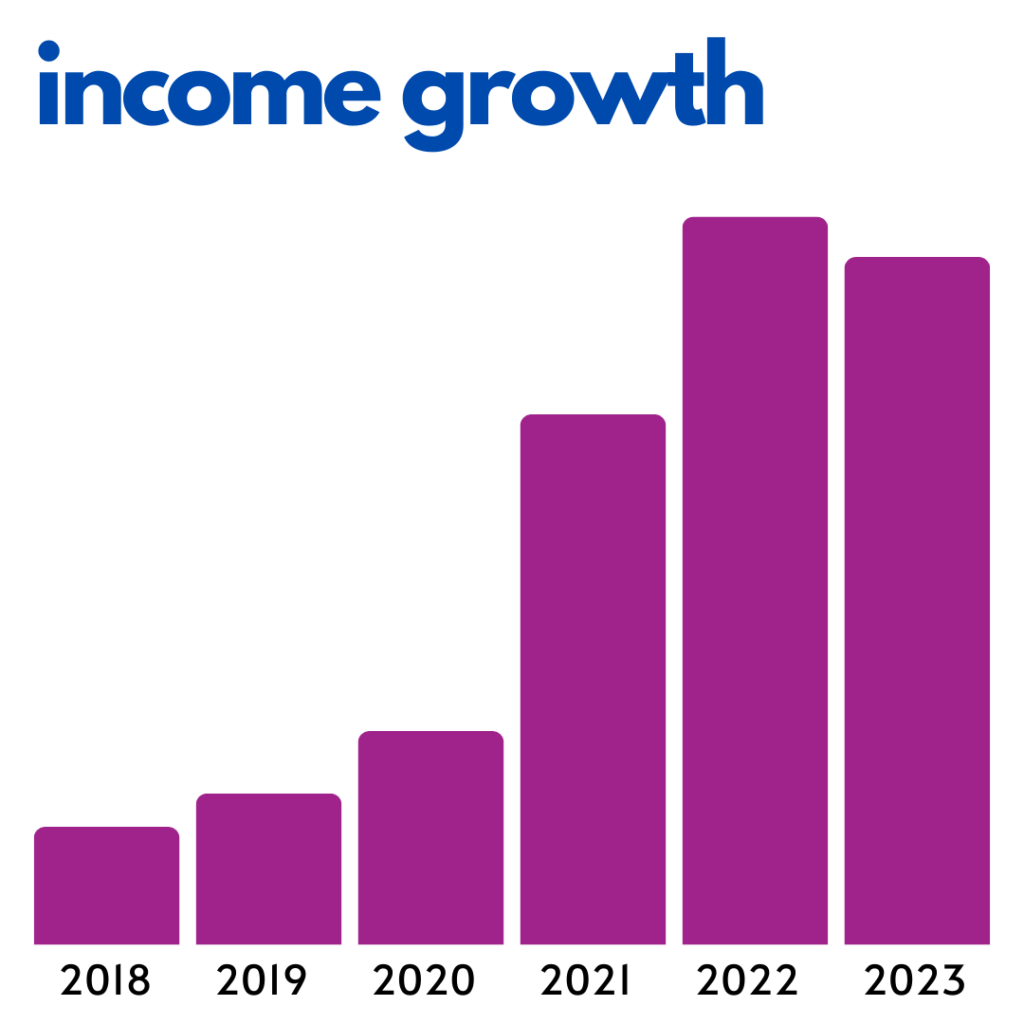
I am in a life stage where time constraints are very, very real! With my full-time job and family life, I do not have any more hours that I can commit to my quilting business. To increase my income within my current time constraints, I’d need more offerings that can generate passive income or recurring income, such as:
- Write more patterns and/or devote more effort to my marketing strategies to increase sales of my current/future patterns.
- Develop additional on-demand online course/education offerings.
- Start a Patreon and/or membership.
I am interested in the first two items, so you will see new patterns and potentially an online course or two from me next year. However, I currently have zero interest in running a Patreon or membership so don’t hold your breath for that one.
For 2024, I am focused on generally maintaining the status quo. I am not consciously trying to increase my income, but rather continuing to focus on the steady variety of things that have been working for a few years now. If my income goes up, great! But if it drops a bit more, that’s ok too.
If you are reading this and trying to draw any parallels to your own creative business numbers, I think it’s important for you — and me!! — to remember that quilting is a small business for me that 1) I greatly enjoy, and 2) I absolutely need to scale to fit around the other important things in my life. (Some weeks I succeed at that scaling/balance more than others.)
Your business and your business goals are yours and yours alone to set and pursue. Good luck and best wishes to all of us in 2024!
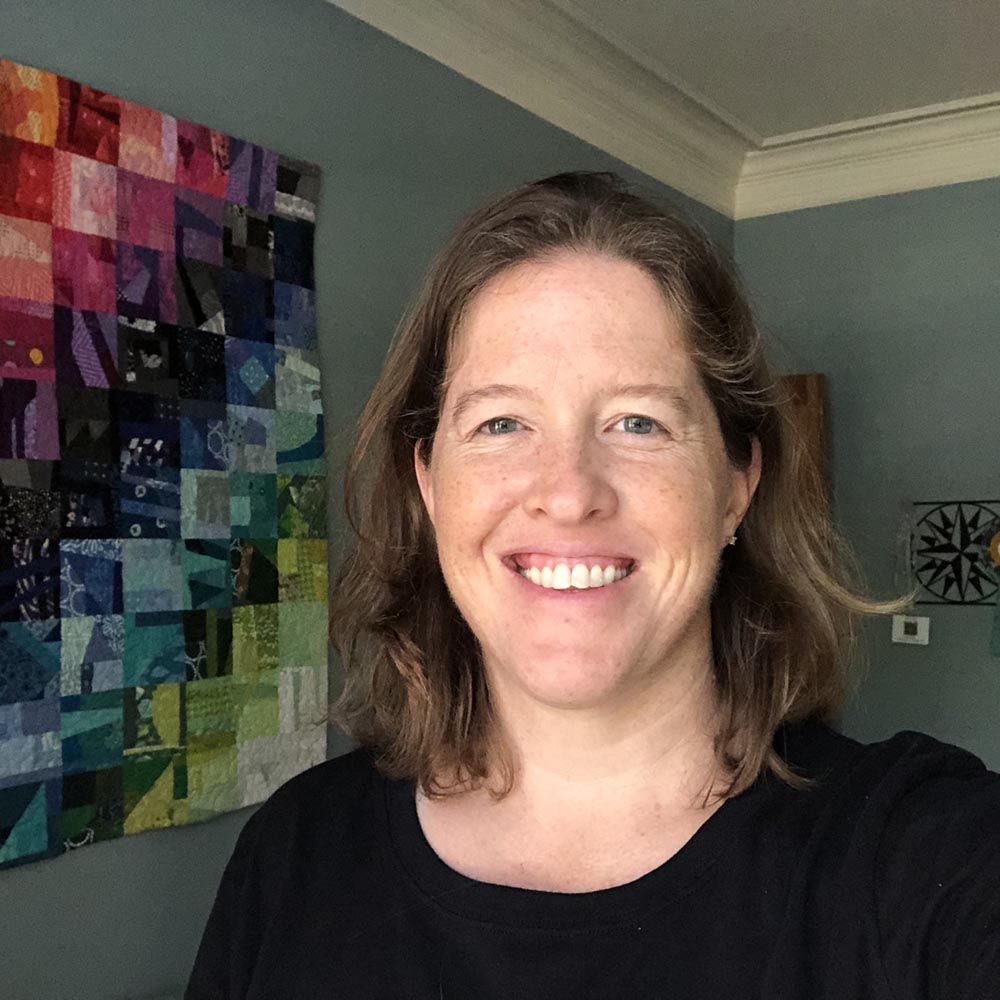
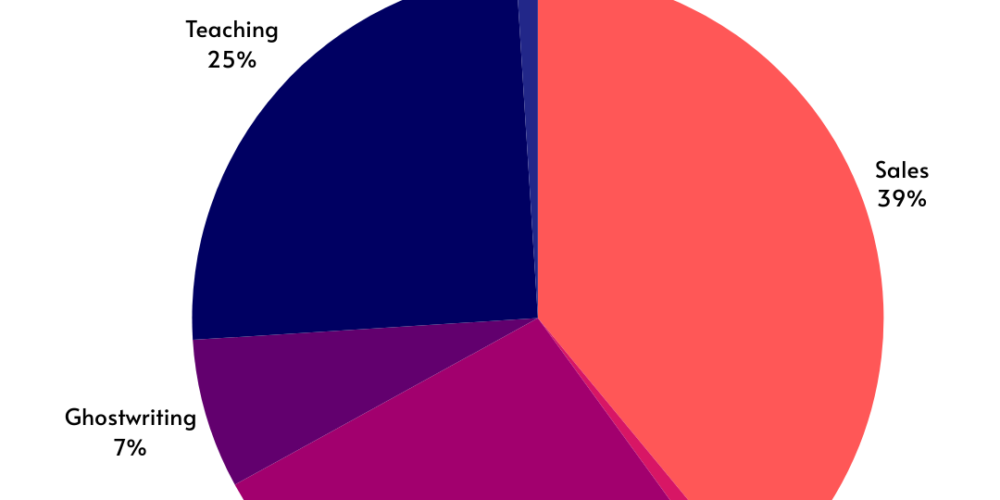


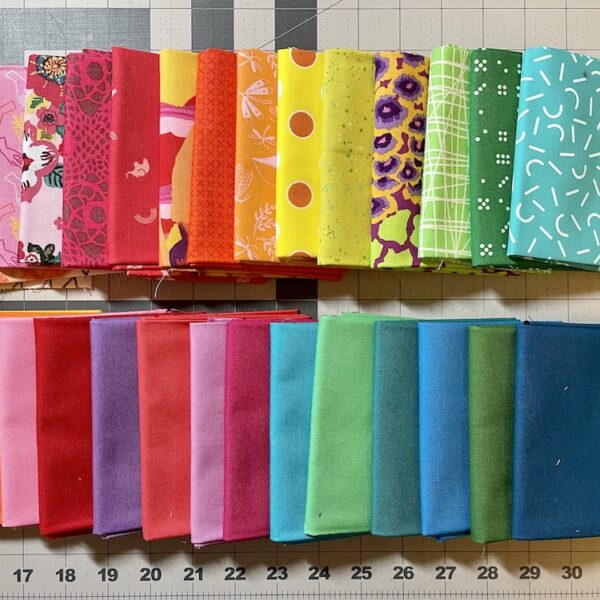





Thanks for sharing- really interesting!
I think it is really generous of you to share this information so openly for those who might be interested in pursuing income in the same area. (Not me, but I still find it very interesting.)
Do you track your hours, and if so do you allocate them to the same income buckets (eg ghostwriting, tech editing, etc.)? It would be interesting to know which was most profitable in terms of time invested. I’m also curious how quilting income compares on an hourly basis to aerospace.
Also, what is ghostwriting?
I track my hours for tech editing and ghostwriting since those are services where my clients pay an hourly rate, but I don’t track hours for the other income categories. Still, I would hazard a guess that on a per hour basis, teaching is most profitable, followed by editing/ghostwriting, with pattern writing as least profitable. For me anyway.
On an hourly basis, I definitely make more as an engineer.
Ghostwriting is when I write part or all of a pattern for someone else, and they publish it under their name.
The Instagram Reels bonus did feel a bit too good to be true, and I’m still bummed it went away, too! Thanks for the detailed breakdown of everything, and I think it was smart to look at the numbers both with and without your longarm sale/purchase. I’m really glad we worked together for the webinar!